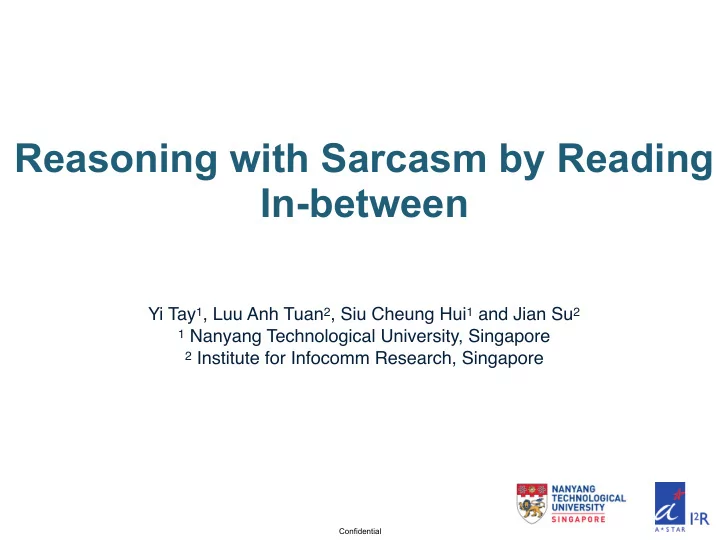

Reasoning with Sarcasm by Reading In-between Yi Tay 1 , Luu Anh Tuan 2 , Siu Cheung Hui 1 and Jian Su 2 1 Nanyang Technological University, Singapore 2 Institute for Infocomm Research, Singapore Confidential
Background • Sarcasm: o “ a form of verbal irony that is intended to express contempt or ridicule ” (The Free Dictionary) o commonly manifests on social communities (e.g. Twitter, Reddit) • Prior work considered sarcasm to be a contrast between a positive and negative sentiment (Riloff et al., 2013) “I love to be ignored!” “Perfect movie for people who can’t fall asleep” • Scope of this work: sarcasm detection based on document’s content and commonsense knowledge but not external knowledge, or user’s profile and context “I love to solve math problem everyday” “Cool. It took me 10 hours to flight from Sydney to Melbourne.” Confidential
Motivation • State-of-the-art sarcasm detection systems mainly rely on deep and sequential neural networks (Ghosh and Veale, 2016; Zhang et al., 2016): o compositional encoders (GRU, LSTM) are often employed, with the input document being parsed one word at a time o no explicit interaction between word pairs � hampers ability to explicitly model contrast, incongruity or juxtaposition of situations o difficult to capture long-range dependencies Confidential � 3
Proposed approach • Our idea: modeling contrast in order to reason with sarcasm o either between positive-negative sentiments or between literal- figurative scenarios • How? o looking in-between: propose a multi-dimensional intra-attention recurrent network � capture both word-word relationship and long-range dependency “I absolutely love to be ignored!” “Perfect movie for people who can’t fall asleep” Confidential � 4
Architecture single-dimensional intra-attention: multi-dimensional intra-attention: intra-attention weight vector: Confidential � 5
Experiments Confidential � 6
Experimental results Confidential � 7
Experimental results Confidential � 8
Experimental results Confidential � 9
Visualization of attention weights Confidential � 10
Conclusion • We proposed a new neural network architecture for sarcasm detection o incorporates a multi-dimensional intra-attention component that learns an intra-attentive representation of the sentence o enabling it to detect contrastive sentiment, situations and incongruity • outperforms strong state-of-the-art baselines such as GRNN and CNN-LSTM-DNN over six public benchmarks • Able to learns highly interpretable attention weights � paving the way for more explainable neural sarcasm detection methods. Confidential � 11
References [1] Ellen Riloff, Ashequl Qadir, Prafulla Surve, Lalindra De Silva, Nathan Gilbert, and Ruihong Huang. 2013. Sarcasm as contrast between a positive sentiment and negative situation . In proceedings of EMNLP, 2013. [2] Meishan Zhang, Yue Zhang, and Guohong Fu. 2016. Tweet sarcasm detection using deep neural network . In proceedings of COLING, 2016. [3] Aniruddha Ghosh and Tony Veale. 2016. Fracking sarcasm using neural network . In proceedings of NAACL, 2016. Confidential � 12
Recommend
More recommend